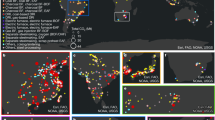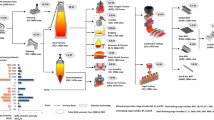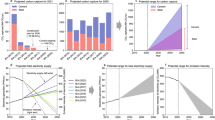Abstract
The critical role of the iron and steel industry in decarbonizing global energy systems calls for refined strategies of climate mitigation. Here, based on a newly developed database of individual iron and steel facilities worldwide, we explore the distinct differences in age-to-capacity ratio and emissions intensity of primary steelmaking plants. We customize regional cost-effective decarbonization strategies by targeting a certain proportion of plants. We find that the more effective indicator for targeted decarbonization in developing regions is emissions intensity, while for developed countries it is age-to-capacity ratio. Whichever indicator we use to target plants, the strategy of transformation towards secondary steelmaking is generally more cost-effective than efficiency improvement in most cases, although obvious regional priorities exist. Our results emphasize the region-specific priorities of mitigation indicators and strategies in targeting plants, which help with designing short-term, cost-effective strategies for reducing steel-related CO2 emissions.
This is a preview of subscription content, access via your institution
Access options
Access Nature and 54 other Nature Portfolio journals
Get Nature+, our best-value online-access subscription
$29.99 / 30 days
cancel any time
Subscribe to this journal
Receive 12 print issues and online access
$209.00 per year
only $17.42 per issue
Buy this article
- Purchase on Springer Link
- Instant access to full article PDF
Prices may be subject to local taxes which are calculated during checkout





Similar content being viewed by others
Data availability
The GISD data used in this study are publicly available at both https://zenodo.org/record/8237523 and http://gidmodel.org/dataset-gisd (also for future regular updates). The development of the GISD relies on the MCI database, which is used with permission and by licence. The MCI database is available from its original creator, Metal Consulting International (https://www.metalsconsultinginternational.com/), and we have no right to publish the information collected from MCI. Instead, we provided detailed instructions on how to access the database from MCI (for example, contact information, product name and product format) and provided the plant/facility ID in the MCI database that can be used to link with the GISD at facility level. The CISD is built based on the official facility-level statistical data from the Ministry of Ecology and Environment of the People’s Republic of China, and we do not have permission to publish the data. Source data are provided with this paper.
Code availability
The code used to manipulate the data and generate the results is available from the corresponding author on reasonable request.
References
Pauliuk, S., Milford, R. L., Müller, D. B. & Allwood, J. M. The steel scrap age. Environ. Sci. Technol. 47, 3448–3454 (2013).
Steel Statistical Yearbook (World Steel Association, 1990–2020); https://www.worldsteel.org/steel-by-topic/statistics/steel-statistical-yearbook.html
Iron and Steel Technology Roadmap: Towards More Sustainable Steelmaking (International Energy Agency, 2020); https://www.iea.org/reports/iron-and-steel-technology-roadmap
Climate Change and the Production of Iron and Steel (World Steel Association, 2021); https://worldsteel.org/publications/policy-papers/climate-change-policy-paper/
Fennell, P., Driver, J., Bataille, C. & Davis, S. J. Cement and steel—nine steps to net zero. Nature 603, 574–577 (2022).
Davis, S. J. et al. Net-zero emissions energy systems. Science 360, eaas9793 (2018).
Bashmakov, I. A. et al. in Climate Change 2022: Mitigation of Climate Change (eds Shukla, P. R. et al.) Ch. 11 (IPCC, Cambridge Univ. Press, 2022).
Fan, Z. & Friedmann, S. J. Low-carbon production of iron and steel: technology options, economic assessment, and policy. Joule 5, 829–862 (2021).
Skoczkowski, T. et al. Technology innovation system analysis of decarbonisation options in the EU steel industry. Energy 212, 118688 (2020).
Hatayama, H., Daigo, I., Matsuno, Y. & Adachi, Y. Outlook of the world steel cycle based on the stock and flow dynamics. Environ. Sci. Technol. 44, 6457–6463 (2010).
Wang, P. et al. Efficiency stagnation in global steel production urges joint supply- and demand-side mitigation efforts. Nat. Commun. 12, 2066 (2021).
Wang, P. et al. Regional disparities in steel production and restrictions to progress on global decarbonization: a cross-national analysis. Renew. Sustain. Energy Rev. 161, 112367 (2022).
Hoesly, R. M. et al. Historical (1750–2014) anthropogenic emissions of reactive gases and aerosols from the Community Emissions Data System (CEDS). Geosci. Model Dev. 11, 369–408 (2018).
Crippa, M. et al. Fossil CO2 Emissions of all World Countries—2020 Report (European Commission, Joint Research Centre, Publications Office, 2020); https://op.europa.eu/en/publication-detail/-/publication/71b9adf3-f3dc-11ea-991b-01aa75ed71a1/language-en
Kurokawa, J. et al. Emissions of air pollutants and greenhouse gases over Asian regions during 2000–2008: Regional Emission inventory in Asia (REAS) version 2. Atmos. Chem. Phys. 13, 11019–11058 (2013).
Liu, Z. et al. Carbon Monitor, a near-real-time daily dataset of global CO2 emission from fossil fuel and cement production. Sci. Data 7, 392 (2020).
Bo, X. et al. Effect of strengthened standards on Chinese ironmaking and steelmaking emissions. Nat. Sustain. 4, 811–820 (2021).
Vogl, V., Olsson, O. & Nykvist, B. Phasing out the blast furnace to meet global climate targets. Joule 5, 2646–2662 (2021).
Hasanbeigi, A., Arens, M., Cardenas, J. C. R., Price, L. & Triolo, R. Comparison of carbon dioxide emissions intensity of steel production in China, Germany, Mexico, and the United States. Resour. Conserv. Recycl. 113, 127–139 (2016).
Kim, J. et al. Decarbonizing the iron and steel industry: a systematic review of sociotechnical systems, technological innovations, and policy options. Energy Res. Soc. Sci. 89, 102565 (2022).
Pardo, N. & Moya, J. A. Prospective scenarios on energy efficiency and CO2 emissions in the European iron & steel industry. Energy 54, 113–128 (2013).
Naito, M., Takeda, K. & Matsui, Y. Ironmaking technology for the last 100 years: deployment to advanced technologies from introduction of technological know-how, and evolution to next-generation process. ISIJ Int. 55, 7–35 (2015).
Wang, K., Wang, C., Lu, X. & Chen, J. Scenario analysis on CO2 emissions reduction potential in China’s iron and steel industry. Energy Policy 35, 2320–2335 (2007).
Ryan, N. A., Miller, S. A., Skerlos, S. J. & Cooper, D. R. Reducing CO2 emissions from U.S. steel consumption by 70% by 2050. Environ. Sci. Technol. 54, 14598–14608 (2020).
Ziebik, A., Lampert, K. & Szega, M. Energy analysis of a blast-furnace system operating with the Corex process and CO2 removal. Energy 33, 199–205 (2008).
Serrenho, A. & Allwood, J. Material stock demographics: cars in Great Britain. Environ. Sci. Technol. 50, 3002–3009 (2016).
Zhang, Q. et al. Drivers of improved PM2.5 air quality in China from 2013 to 2017. Proc. Natl Acad. Sci. USA 116, 24463 (2019).
Zhou, K. & Yang, S. Emission reduction of China’s steel industry: progress and challenges. Renew. Sustain. Energy Rev. 61, 319–327 (2016).
Lang, J. et al. Net Zero Tracker (Energy and Climate Intelligence Unit, Data-Driven EnviroLab, NewClimate Institute, Oxford Net Zero, 2023); https://zerotracker.net/
Net Zero by 2050: A Roadmap for the Global Energy Sector (International Energy Agency, 2021); https://www.iea.org/reports/net-zero-by-2050
Lei, T. et al. Global iron and steel plant CO2 emissions and carbon-neutrality pathways. Nature https://doi.org/10.1038/s41586-023-06486-7 (2023).
Wübbeke, J. & Heroth, T. Challenges and political solutions for steel recycling in China. Resour. Conserv. Recycl. 87, 1–7 (2014).
Aylen, J. & Albertson, K. Markets in ferrous scrap for steelmaking. Ironmak. Steelmak. 33, 203–212 (2006).
Global Steel at a Crossroads. Why the Global Steel Sector Needs to Invest in Climate-Neutral Technologies in the 2020s (Agora Industry, Wuppertal Institute & Lund Univ., 2021); https://www.agora-energiewende.de/en/publications/global-steel-at-a-crossroads/
Global Facility Level Net-Zero Steel Pathways: Technical Report on the First Scenarios of the Net-Zero Steel Project (Institute for Sustainable Development and International Relations, 2021); https://netzerosteel.org/publications/
Iron and Steel Database (Metal Consulting International Limited, 2019); https://www.metalsconsultinginternational.com/
Global Steel Plant Tracker (Global Energy Monitor, 2022); https://globalenergymonitor.org/projects/global-steel-plant-tracker/
World Energy Statistics and Balances 2021 (International Energy Agency, 2021); https://www.iea.org/reports/world-energy-balances-overview
Industrial Commodity Statistics Database (United Nations Statistics Division, 2020); https://unstats.un.org/unsd/industry/Commodity/
Tong, D. et al. Targeted emission reductions from global super-polluting power plant units. Nat. Sustain. 1, 59–68 (2018).
Chen, C. et al. A striking growth of CO2 emissions from the global cement industry driven by new facilities in emerging countries. Environ. Res. Lett. 17, 044007 (2022).
Maruyama, N. & Eckelman, M. J. Long-term trends of electric efficiencies in electricity generation in developing countries. Energy Policy 37, 1678–1686 (2009).
IPCC. 2006 IPCC Guidelines for National Greenhouse Gas Inventories (eds Penman, J. et al.) (IPCC, 2006); https://www.ipcc-nggip.iges.or.jp/public/2006gl/
Liu, Z. et al. Reduced carbon emission estimates from fossil fuel combustion and cement production in China. Nature 524, 335–338 (2015).
Qin, X. et al. Global and regional drivers of power plant CO2 emissions over the last three decades revealed from unit-based database. Earth’s Future 10, e2022EF002657 (2022).
Wang, X. et al. A unit-based emission inventory of SO2, NOx and PM for the Chinese iron and steel industry from 2010 to 2015. Sci. Total Environ. 676, 18–30 (2019).
Latest Developments in Steelmaking Capacity (OECD Steel Committee, 2021); https://www.oecd.org/sti/ind/steelcapacity.htm
Tong, D. et al. Committed emissions from existing energy infrastructure jeopardize 1.5 °C climate target. Nature 572, 373–377 (2019).
Acknowledgements
This work is supported by the National Natural Science Foundation of China (41921005), Tsinghua University Initiative Scientific Research Program (20223080041), the Energy Foundation (G-2009-32416) and the New Cornerstone Science Foundation through the Xplorer Prize. We thank D. Guan for helpful discussion and cooperative development of the GISD.
Author information
Authors and Affiliations
Contributions
Q.Z. and D.T. designed the study. R.X. performed dataset construction and emission estimates with support from J.C., Q.S., X.Q., C.C., L.Y., X.Y., H.W. and D.Z. on data compilation and from Y.L. on analytical approaches. D.T., R.X., Q.Z. and K.H. interpreted the data. R.X. D.T., S.J.D. and Q.Z. wrote the paper with input from all co-authors.
Corresponding author
Ethics declarations
Competing interests
The authors declare no competing interests.
Peer review
Peer review information
Nature Climate Change thanks Sami Kara, Peng Wang and the other, anonymous, reviewer(s) for their contribution to the peer review of this work.
Additional information
Publisher’s note Springer Nature remains neutral with regard to jurisdictional claims in published maps and institutional affiliations.
Extended data
Extended Data Fig. 1 Diagram about major steelmaking processes and routes.
The pretreatment, ironmaking, and steelmaking processes can be combined to generate three main steelmaking routes: BOF/OHF primary steelmaking route, EAF primary steelmaking route, and secondary steelmaking route. The two primary routes convert raw iron ore to crude steel through the pretreatment, ironmaking, and steelmaking processes, among which the BOF/OHF primary steelmaking route mainly relies on pig iron from BF, while the EAF primary steelmaking route generally use DRI-produced iron. Different from primary routes, the secondary steelmaking route uses steel scrap as major input, and converts it to crude steel in EAF.
Extended Data Fig. 2 Steelmaking capacity development.
The marker size is proportional to the total capacity of the region in 1990, 2000, 2010, and 2019. The numbers above the markers and lines represent the capacity of the targeted year and the relative changes between two targeted years, respectively.
Extended Data Fig. 3 Driver decomposition of historic CO2 emissions from global iron and steel industry.
The contribution of drivers to the CO2 emission changes (a) at global scale and in (b) China, (c) India, (d) Rest of Asia, (e) the U.S., (f) Canada and Latin America, (g) Western Europe, (h) Eastern Europe and Russia, and (i) Rest of World. The drivers here include production growth (yellow), production route shift (orange; that is the proportions of primary and secondary steelmaking), and efficiency improvement (deep blue).
Extended Data Fig. 4 Age-to-capacity ratio and emission intensity disproportionalities of primary steelmaking plants.
The same as Fig. 1b,c but the primary steelmaking plants are distinguished by region in 1990 and 2019.
Extended Data Fig. 5 Maps of targeted primary steelmaking plants identified by different percentiles (90th, 75th, and 50th percentiles) of (a) age-to-capacity ratio and (b) CO2 emission intensity indicators, respectively.
The plants are classified by direct CO2 emissions (<100 kt, 100–499 kt, 500–999 kt, 1,000–4,999 kt, and ≥ 5,000 kt) and the largest quantiles according to which they are identified as targeted ones.
Extended Data Fig. 6 The targeted primary steelmaking plants and national net-zero climate goals.
The shares of number and capacity of targeted primary steelmaking plants that are located in countries with net-zero climate goals29 according to age-to-capacity ratio ((a) and (b); top panel) and emission intensity ((c) and (d); bottom panel) indicators. In the left and right columns, the shares are distinguished by the target year (2050 or earlier, 2051–2060, or after 2060) and status (achieved, in law, in policy document, declaration/pledge, proposed/in discussion) of net-zero climate goals, respectively.
Supplementary information
Supplementary Information
Supplementary Text 1–8, Figs. 1–28 and Tables 1–14.
Source data
Source Data Fig. 1
Statistical source data.
Source Data Fig. 2
Statistical source data.
Source Data Fig. 3
Statistical source data.
Source Data Fig. 4
Statistical source data.
Source Data Fig. 5
Statistical source data.
Source Data Extended Data Fig. 2
Statistical source data.
Source Data Extended Data Fig. 3
Statistical source data.
Source Data Extended Data Fig. 4
Statistical source data.
Source Data Extended Data Fig. 5
Statistical source data.
Source Data Extended Data Fig. 6
Statistical source data.
Rights and permissions
Springer Nature or its licensor (e.g. a society or other partner) holds exclusive rights to this article under a publishing agreement with the author(s) or other rightsholder(s); author self-archiving of the accepted manuscript version of this article is solely governed by the terms of such publishing agreement and applicable law.
About this article
Cite this article
Xu, R., Tong, D., Davis, S.J. et al. Plant-by-plant decarbonization strategies for the global steel industry. Nat. Clim. Chang. 13, 1067–1074 (2023). https://doi.org/10.1038/s41558-023-01808-z
Received:
Accepted:
Published:
Issue Date:
DOI: https://doi.org/10.1038/s41558-023-01808-z
This article is cited by
-
Cost-effectiveness uncertainty may bias the decision of coal power transitions in China
Nature Communications (2024)
-
MEIC-global-CO2: A new global CO2 emission inventory with highly-resolved source category and sub-country information
Science China Earth Sciences (2024)



